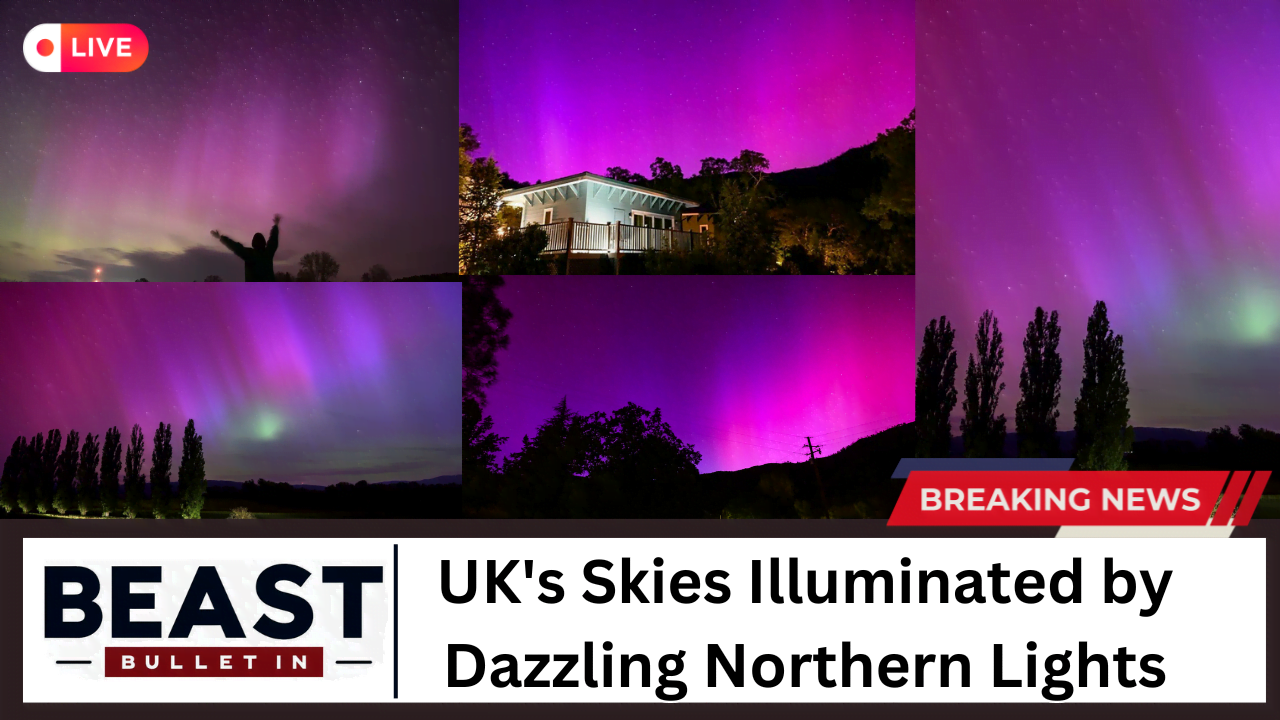The Phenomenon
In a celestial event of breathtaking proportions, the Northern Lights, also known as the Aurora Borealis, graced the skies above the United Kingdom for two consecutive nights. This mesmerizing display of vibrant, dancing lights was the result of an intense solar storm, the likes of which had not been witnessed in nearly two decades.
The Northern Lights are a natural phenomenon that occurs when charged particles from the Sun interact with the Earth’s magnetic field. These particles, carried by solar winds, collide with gases in the planet’s atmosphere, causing them to release photons of varying colors. The result is a captivating light show that typically adorns the night skies near the Earth’s polar regions.
The Catalyst: A Powerful Solar Storm
The recent celestial extravaganza was triggered by a series of powerful solar flares and coronal mass ejections (CMEs) that erupted from the Sun’s surface. These explosive events unleashed a massive burst of plasma and magnetically charged particles, which hurtled towards Earth at staggering speeds.
Scientists from the National Oceanic and Atmospheric Administration (NOAA) classified the initial solar storm on Friday as a G5 event, the highest level on the geomagnetic storm scale. This rating indicates an “extreme” disturbance, the first of its kind since the “Halloween Storms” of October 2003, which caused power outages and disruptions to communication systems across multiple countries.
Widespread Sightings and Awe-Inspiring Displays
As the solar storm’s impact intensified, the Northern Lights became visible across vast swaths of the United Kingdom, captivating skywatchers from the northernmost regions to areas as far south as Sussex and London. Typically confined to the far northern latitudes, the Aurora Borealis treated observers to a breathtaking display of shimmering greens, pinks, and scarlets that danced across the night sky.
Residents and visitors alike took to social media, sharing stunning photographs and videos of the celestial phenomenon. From the picturesque landscapes of Scotland to the bustling streets of London, the Northern Lights painted the heavens with their ethereal hues, leaving onlookers in awe.
Global Impact and Celestial Wonders
The solar storm’s effects were not limited to the UK alone. Observers from various parts of the world, including Europe, the Americas, and even the remote region of Ladakh in India, reported witnessing the Northern Lights in all their glory.
In Ladakh, the skies dazzled with a vibrant red hue, a rare sight caused by the heating of the atmosphere due to the intense space weather phenomenon. Indian solar physicist Dibyendu Nandi explained that these “auroral red arcs” are typically observed during severe geomagnetic storms, when electric currents circulate between the Earth and outer space, enhancing the likelihood of such extraordinary displays.
Potential Disruptions and Precautions
While the Northern Lights provided a breathtaking spectacle, the solar storm also posed potential risks to various systems on Earth. Intense geomagnetic storms can disrupt radio transmissions, satellite navigation systems, and even power grids, leading to blackouts and communication outages.
Elon Musk’s Starlink internet satellites, which account for a significant portion of the satellites currently in orbit, reported experiencing “degraded service” due to the strong magnetic disturbance caused by the solar storm. Authorities and utility companies took precautionary measures to mitigate potential disruptions, with some commercial airlines opting for more southerly routes to avoid the storm’s impact.
Scientific Insights and Future Predictions
Scientists and space weather experts closely monitored the solar storm’s progression, gathering valuable data and insights into these celestial phenomena. They predicted that the Northern Lights might continue to be visible in the coming days, as solar wind activity is expected to ramp up further.
Dr. Nandi, the Indian solar physicist, warned that the space environment remains disturbed, and additional solar storms with southward magnetic fields could have a more severe impact on low-Earth orbiting satellites. Experts suspect that more solar storms impacting Earth in the coming days may likely affect satellites in orbit, potentially causing further disruptions.
A Rare Opportunity for Observation and Appreciation
Despite the potential risks, the Northern Lights’ appearance in the UK skies presented a rare and captivating opportunity for observation and appreciation. Skywatchers and amateur astronomers alike seized the chance to witness this celestial spectacle, often venturing to areas with minimal light pollution to enhance their viewing experience.
Photographers and videographers captured mesmerizing images and footage, showcasing the Northern Lights in all their glory. These visual records not only serve as cherished mementos but also contribute to scientific research and our understanding of these natural wonders.
Advice for Optimal Viewing
For those hoping to catch a glimpse of the Northern Lights in the coming nights, meteorologists and experts offered valuable advice. They recommended finding a location with minimal light pollution, preferably in rural or remote areas, and looking towards the northern horizon during the late evening and early morning hours.
Additionally, the use of camera equipment, particularly those capable of long exposures, can enhance the visibility of the Aurora Borealis, capturing details that may be missed by the naked eye. Patience and perseverance were also emphasized, as the intensity and duration of the Northern Lights can vary depending on the solar activity and atmospheric conditions.
Awe-Inspiring Moments and Lasting Impressions
As the solar storm’s impact waned, skywatchers across the UK and beyond reflected on the awe-inspiring moments they had witnessed. The Northern Lights, with their ethereal beauty and captivating dance, left a lasting impression on those fortunate enough to experience this celestial phenomenon.
For many, the sight of the Aurora Borealis painted across familiar landscapes and cityscapes was a humbling reminder of the grandeur and mysteries of the cosmos. It served as a reminder that even in our modern, technologically advanced world, nature still holds the power to awe and inspire us with its breathtaking displays.
Scientific Exploration and Future Discoveries
The recent solar storm and the accompanying Northern Lights have reignited scientific curiosity and sparked renewed interest in space weather research. Scientists around the world are analyzing the data gathered during this event, seeking to unravel the intricacies of solar activity and its impact on Earth’s environment.
By studying these phenomena, researchers hope to gain insights that could lead to improved forecasting capabilities, enabling better preparedness for future solar storms and their potential consequences. Additionally, the observations made during this celestial event may contribute to our understanding of the Earth’s magnetic field, atmospheric dynamics, and the complex interplay between our planet and the Sun.
Conclusion: A Celestial Reminder
The appearance of the Northern Lights in the UK skies, amid the breathtaking solar storm, served as a celestial reminder of the awe-inspiring wonders that nature has to offer. It was a reminder that, even in our modern world, the cosmos still holds the power to captivate and inspire us with its beauty and mysteries.
As we look to the future, this celestial event has ignited a renewed sense of curiosity and appreciation for the natural world. It has encouraged us to embrace the pursuit of scientific knowledge, to explore the depths of the cosmos, and to cherish the fleeting moments when nature’s grandeur is put on display for all to witness.






















